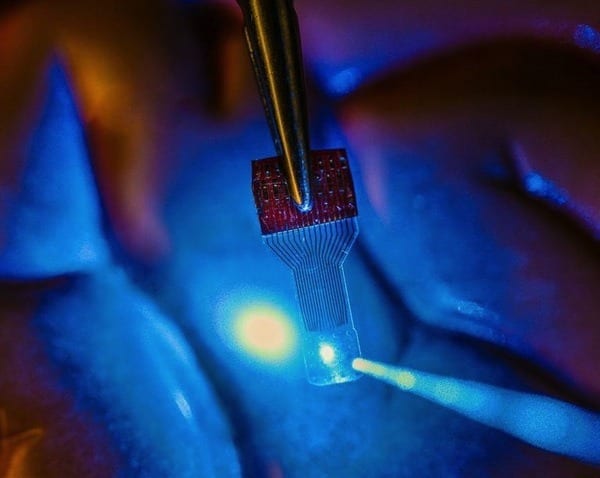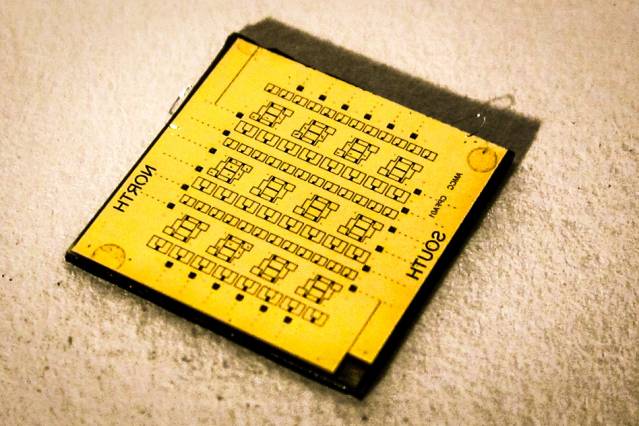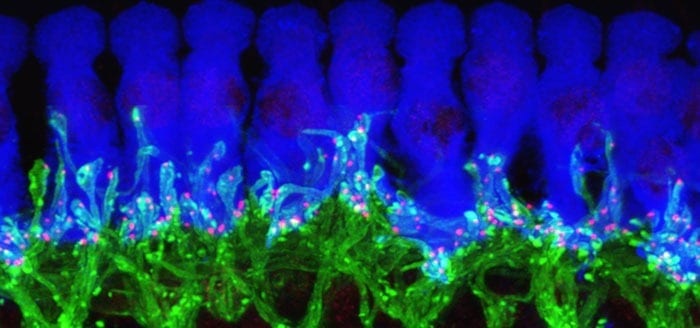
Photo: Justin Williams research group
Developing invisible implantable medical sensor arrays, a team of University of Wisconsin-Madison engineers has overcome a major technological hurdle in researchers’ efforts to understand the brain.
The team described its technology, which has applications in fields ranging from neuroscience to cardiac care and even contact lenses, in the Oct. 20 issue of the online journal Nature Communications.
Neural researchers study, monitor or stimulate the brain using imaging techniques in conjunction with implantable sensors that allow them to continuously capture and associate fleeting brain signals with the brain activity they can see. However, it’s difficult to see brain activity when there are sensors blocking the view.
“One of the holy grails of neural implant technology is that we’d really like to have an implant device that doesn’t interfere with any of the traditional imaging diagnostics,” says Justin Williams, a professor of biomedical engineering and neurological surgery at UW-Madison. “A traditional implant looks like a square of dots, and you can’t see anything under it. We wanted to make a transparent electronic device.”
The researchers chose graphene, a material gaining wider use in everything from solar cells to electronics, because of its versatility and biocompatibility. And in fact, they can make their sensors incredibly flexible and transparent because the electronic circuit elements are only 4 atoms thick—an astounding thinness made possible by graphene’s excellent conductive properties. “It’s got to be very thin and robust to survive in the body,” says Zhenqiang (Jack) Ma, a professor of electrical and computer engineering at UW-Madison. “It is soft and flexible, and a good tradeoff between transparency, strength and conductivity.”
Drawing on his expertise in developing revolutionary flexible electronics, he, Williams and their students designed and fabricated the microelectrode arrays, which — unlike existing devices — work in tandem with a range of imaging technologies. “Other implantable microdevices might be transparent at one wavelength, but not at others, or they lose their properties,” says Ma. “Our devices are transparent across a large spectrum — all the way from ultraviolet to deep infrared.”
The Latest on: See-through sensors
[google_news title=”” keyword=”See-through sensors” num_posts=”10″ blurb_length=”0″ show_thumb=”left”]
via Google News
The Latest on: See-through sensors
- Good Vibrations: MEMS Sensor Grabs Voice Commandson April 24, 2024 at 12:40 pm
As wireless devices proliferate and systems gain processing power, the demand grows for those devices and systems to accept real-world sound inputs such as voice commands. Theres ...
- Leidos Gets U.S. Army ISR Sensor Contracton April 24, 2024 at 7:01 am
The U.S. Army has awarded Leidos a major sustainment contract for its future high-altitude intelligence, surveillance and reconnaissance (ISR) fleet as the company is competing for an upcoming program ...
- Bota Systems launches PixONE force-torque sensors for roboticson April 23, 2024 at 10:09 am
Bota Systems says it designed its new PixONE force-torque sensors for ease of integration and to keep cabling inside robotic arms.
- Save $40 on the ingenious Nix Mini Color Sensoron April 21, 2024 at 3:07 am
Already thinking about all your spring cleaning projects? If you’re doing any painting, you may be tempted to trust swatches or the naked eye to find the right colors. But a better solution exists, ...
- Unlocking sustainable success: SAS harnesses the power of IoT sensors for a better futureon April 19, 2024 at 10:08 am
Discover how SAS uses IoT sensors to drive sustainability through energy optimization. Explore the potential and impact of IoT sensors in modern society.
- Bota Systems to showcase its latest sensors at Robotics Summiton April 18, 2024 at 11:48 am
Bota Systems will be at Booth 315 on the show floor at the Robotics Summit & Expo, which takes place on May 1 and 2, 2024.
- Indie creatures to the core, David and Nathan Zellner cut their own path through the wildon April 17, 2024 at 1:06 pm
The filmmaking brothers have found a deep emotional connection to a family of mythical creatures led by an unrecognizable Riley Keough and Jesse Eisenberg.
- Ultra-resilient flexible sensors break new ground in pressure detectionon April 16, 2024 at 7:05 am
In recent advancements, flexible pressure sensors have been developed to mimic human skin's sensitivity, significantly benefiting fields like ...
- Lectric XPress e-bike launched as $999 torque sensor commuter electric bikeon April 16, 2024 at 12:20 am
The Lectric XPress is the newest model launched by Lectric Ebikes and is set to turn the commuter e-bike market on its head ...
- NantHealth gets grant for patient data exchange system with configurable sensors for healthcare providerson April 15, 2024 at 6:16 am
Discover how NantHealth's patented system revolutionizes patient data exchange through sensors and a data exchange engine, ensuring efficiency and privacy.
via Bing News










